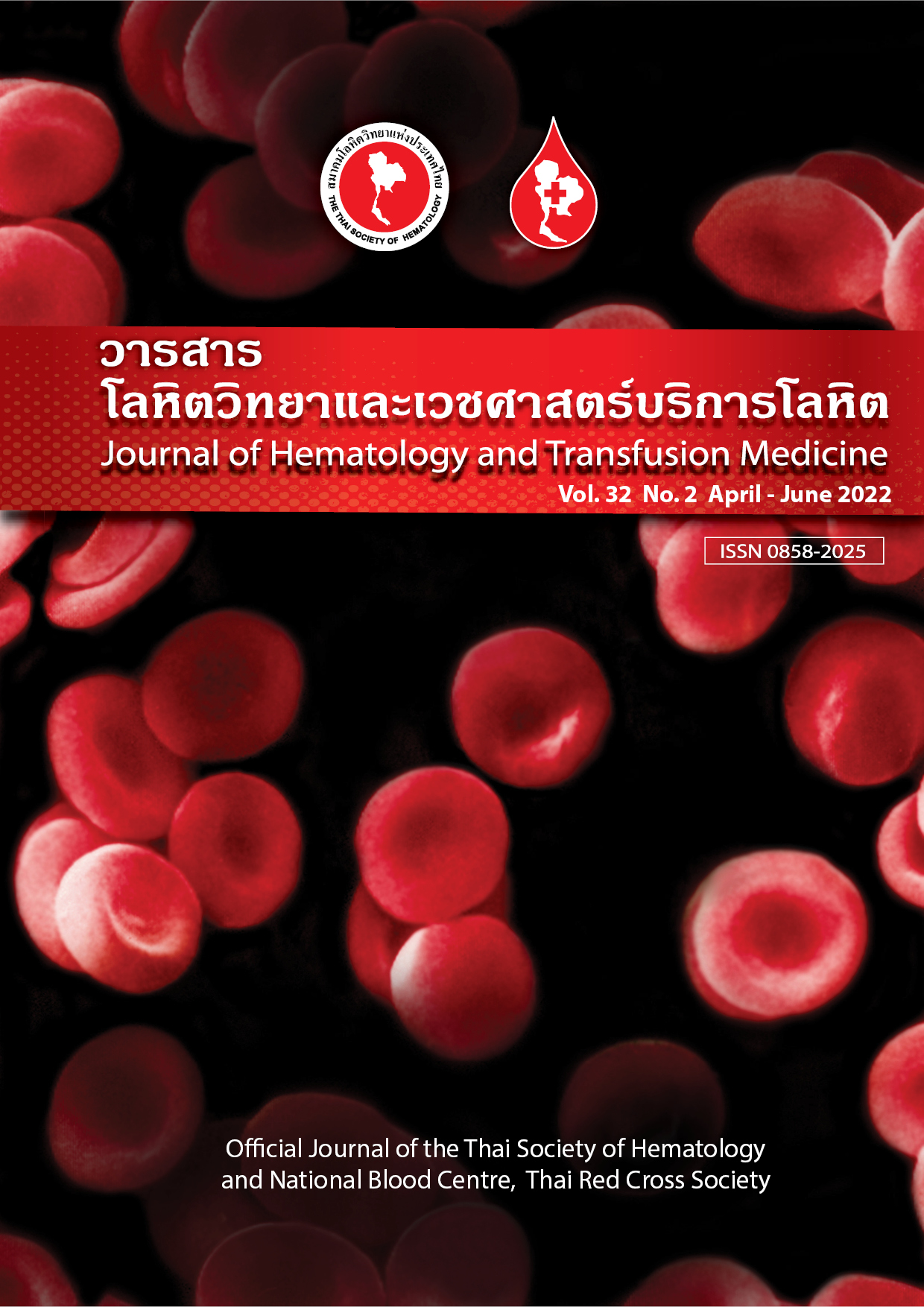Detection of HIV false elite controller in Thai blood donors
Keywords:
Elite controller, HIV, Antiretroviral therapy, อีลิทคอนโทรลเลอร์, เอชไอวี, ยาต้านไวรัสAbstract
Abstract:
Introduction: National Blood Centre, Thai Red Cross Society screens blood samples from every donor for HIV with both serological test and nucleic acid testing (NAT). Potential elite controllers (EC) are donors who tested repeatedly reactive by serology, but non-reactive by NAT. There is no study in Thailand to date to find the cause of this group’s test results whether they are due to genetics (true EC) or antiretroviral therapy (ART) drugs (false EC). Objective: To assess the prevalence of HIV false EC in Thai blood donors who tested reactive by serology, but non-reactive by NAT. Materials and Methods: Seventy stored frozen plasma samples from potential EC collected during July to December 2021 were tested for nucleoside reverse transcriptase inhibitors (NRTIs). Positive samples were further tested for non-nucleoside reverse transcriptase inhibitors (NNRTIs) and protease inhibitors (PIs). In addition, Geenius HIV-1/2 confirmatory assay was also performed for all samples. Results: Of 70 potential ECs from total of 315,170 donors (0.02%) during that period, there was one sample (1.43%) that tested positive for NRTIs (tenofovir and emtricitabine). Efavirenz was also found on further testing for NNRTIs. Geenius HIV-1/2 confirmatory assay was positive for HIV-1. Of 69 potential ECs negative for NRTIs, there was 1 sample (1.45%) tested positive for HIV-1, 2 samples (2.90%) tested indeterminate for HIV-2 and 1 sample (1.45%) that tested indeterminate for HIV-1 by Geenius HIV-1/2 confirmatory assay. Conclusion: The prevalence of false EC due to NRTIs treatment was only 1.43% in HIV serology reactive Thai blood donors and should be further study for the human genetics that may be involved with this group.
บทคัดย่อ
บทนำ ศูนย์บริการโลหิตแห่งชาติ สภากาชาดไทย ตรวจคัดกรองตัวอย่างโลหิตจากผู้บริจาคโลหิตทุกคน ด้วยทั้งวิธีน้ำเหลืองวิทยา และการตรวจหาสารพันธุกรรม ผู้บริจาคโลหิตที่อาจเป็นอีลีทคอนโทรลเลอร์ คือผู้บริจาคที่ผลตรวจน้ำเหลืองวิทยาให้ผลบวกซ้ำ แต่การตรวจหาสารพันธุกรรมให้ผลลบ และยังไม่มีการศึกษาในประเทศไทยถึงสาเหตุของกลุ่มนี้ว่ามาจากพันธุกรรม (อีลีทคอนโทรลเลอร์จริง) หรือการใช้ยาต้านไวรัส (อีลีทคอนโทรลเลอร์ปลอม) วัตถุประสงค์ เพื่อหาความชุกของอีลีทคอนโทรลเลอร์ปลอมในผู้บริจาคโลหิตชาวไทยที่ผลการตรวจด้วยวิธีน้ำเหลืองวิทยาให้ผลบวก แต่การตรวจหาสารพันธุกรรมให้ผลลบ วัสดุและวิธีการ ตัวอย่างพลาสมาแช่แข็งจากผู้บริจาคโลหิต จำนวน 70 ราย ที่อาจเป็นอีลีทคอนโทรลเลอร์ที่เก็บระหว่างเดือนกรกฎาคมถึงเดือนธันวาคม พ.ศ. 2564 นำไปตรวจหายากลุ่ม nucleoside reverse transcriptase inhibitors (NRTIs) ตัวอย่างที่ให้ผลบวกได้รับการตรวจหายากลุ่ม non-nucleoside reverse transcriptase inhibitors (NNRTIs) และ protease inhibitors (PIs) เพิ่มเติม นอกจากนี้ทุกตัวอย่างจะได้รับการตรวจเพิ่มด้วย Geenius HIV-1/2 confirmatory assay ด้วย ผลการศึกษา พบว่ามี 1 ตัวอย่าง (1.43%) ที่ให้ผลบวกกับกลุ่มยา NRTIs (tenofovir และ emtricitabine) จากผู้บริจาคโลหิตที่อาจเป็นอีลีทคอนโทรลเลอร์ 70 คน ซึ่งเท่ากับ 0.02% ของผู้บริจาคโลหิตทั้งหมดในช่วงเวลานั้น ตรวจพบยา efavirenz จากการตรวจเพิ่มเติมกับกลุ่มยา NNRTIs และให้ผลบวกกับ HIV-1 ด้วย การตรวจ Geenius HIV-1/2 confirmatory assay ตัวอย่างอีก 69 ตัวอย่างที่ให้ผลลบกับยา NRTIs มี 1 ตัวอย่าง (1.45%) ให้ผลบวกกับ HIV-1 อีก 2 ตัวอย่าง (2.90%) ให้ผลสรุปไม่ได้กับ HIV-2 และ 1 ตัวอย่าง (1.45%) ให้ผลสรุปไม่ได้กับ HIV-1 จากการตรวจยืนยันด้วย Geenius HIV-1/2 confirmatory assay สรุป ความชุกของอีลีทคอนโทรลเลอร์ปลอมในผู้บริจาคโลหิตชาวไทยที่ผลการตรวจด้วยวิธีน้ำเหลืองวิทยาให้ผลบวก แต่การตรวจหาสารพันธุกรรมให้ผลลบ คือ 1.43% และควรมีการศึกษาเพิ่มเติมทางพันธุกรรมในผู้ติดเชื้อ HIV เพื่อหาสาเหตุที่แท้จริงต่อไป
Downloads
References
Kupatawintu P, Oota S, Kijkriengkraikul N, Limsaiprom P, Kumkrong P, Witthayawiwat P, et al. Annual report 2017 National Blood Centre, Thai Red Cross Society. Bangkok: National Blood Centre, Thai Red Cross Society; 2019.
Sakuldamrongpanich T, Oota S, Kramkratok P, Khuenkaew R, Rattajak P, Pheakkhuntod S, et al. NAT screening for human immunodeficiency virus-1, hepatitis C virus and hepatitis B virus in blood donations at the National Blood Centre and Regional Blood Centres of the Thai Red Cross. J Hematol Transfus Med. 2012;22:93-100.
Costa ASL, Brasiliense DM. HIV seroconversion in blood donors from the coordinating blood bank in the State of Pará. Rev Bras Hematol Hemoter. 2011;33:342-6.
Deeks SG, Walker BD. Human immunodeficiency virus controllers: mechanisms of durable virus control in the absence of antiretroviral therapy. Immunity. 2007;27:406-16.
Hubert JB, Burgard M, Dussaix E, Tamalet C, Deveau C, Le Chenadec J, et al. Natural history of serum HIV-1 RNA levels in 330 patients with a known date of infection. The SEROCO Study Group. AIDS. 2000;14:123-31.
Lambotte O, Boufassa F, Madec Y, Nguyen A, Goujard C, Meyer L, et al. HIV controllers: a homogeneous group of HIV-1-infected patients with spontaneous control of viral replication. Clin Infect Dis. 2005;41:1053-6.
Sykes W, Van den Berg K, Jacobs G, Jauregui A, Roubinian N, Wiesner L, et al. Discovery of false elite controllers: HIV antibody-positive RNA-negative blood donors found to be on antiretroviral therapy. J Infect Dis. 2019;220:643-7.
Hansasuta P. Personal communication; 2020.
Shahar E, Shapiro A, Baskin L, Oz ZK. Antiretroviral therapy-induced negative HIV antibody test following diagnosis of HIV infection. AIDS. 2019;33:1804-5.
Custer B, Quiner C, Haaland R, Martin A, Stone M, Reik R, et al. HIV antiretroviral therapy and prevention use in US blood donors: a new blood safety concern. Blood. 2020;136:1351-8.
Pourhoseingholi MA, Vahedi M, Rahimzadeh M. Sample size calculation in medical studies. Gastroenterol Hepatol Bed Bench. 2013;6:14-7.
Department of Disease Control. Thailand national guidelines on HIV/AIDS treatment and prevention 2017. Bangkok: The Agricultural Cooperative Federation of Thailand Ltd.; 2017. Available from: http://www.thaiaidssociety.org/images/PDF/hiv_thai_guideline_2560.pdf.
Acosta EP, Limoli KL, Trinh L, Parkin NT, King JR, Weidler JM, et al. Novel method to assess antiretroviral target trough concentrations using in vitro susceptibility data. Antimicrob Agents Chemother. 2012;56:5938-45.
Geenius™ HIV 1/2 Confirmatory Assay [package insert]. Marnes-la-Coquette, France: Bio-Rad; 2013.
van den Berg K, Vermeulen M, Louw VJ, Murphy EL, Maartens G. Undisclosed HIV status and antiretroviral therapy use among South African blood donors. Transfusion. 2021;61:2392-400.
UNAIDS. UNAIDS Data 2021. Geneva: Joint United Nations Programme on HIV/AIDS; 2021. Available from: https://www.unaids.org/sites/default/files/media_asset/JC3032_AIDS_Data_book_2021_En.pdf.
National Blood Centre, Thai Red Cross Society. Blood donation manual. 1st ed. Bangkok: National Blood Centre, Thai Red Cross Society; 2021.
Lunardi LW, Bragatte MAS, Vieira GF. The influence of HLA/HIV genetics on the occurrence of elite controllers and a need for therapeutics geotargeting view. Braz J Infect Dis. 2021;25:101619. doi: 10.1016/j.bjid.2021.101619.
Downloads
Published
Issue
Section
License
Copyright (c) 2022 Journal of Hematology and Transfusion Medicine

This work is licensed under a Creative Commons Attribution-NonCommercial-NoDerivatives 4.0 International License.



